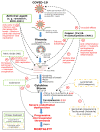COVID-19: The Potential Role of Copper and N-acetylcysteine (NAC) in a Combination of Candidate Antiviral Treatments Against SARS-CoV-2
- PMID: 32503814
- PMCID: PMC8378025
- DOI: 10.21873/invivo.11946
COVID-19: The Potential Role of Copper and N-acetylcysteine (NAC) in a Combination of Candidate Antiviral Treatments Against SARS-CoV-2
Abstract
Background: On March 11, 2020, the World Health Organization (WHO) declared the outbreak of coronavirus disease (COVID-19) a pandemic. Since then, thousands of people have suffered and died, making the need for a treatment of severe acute respiratory syndrome-related coronavirus-2 (SARS-CoV-2) more crucial than ever.
Materials and methods: The authors carried out a search in PubMed, ClinicalTrials.gov and New England Journal of Medicine (NEJM) for COVID-19 to provide information on the most promising treatments against SARS-CoV-2.
Results: Possible COVID-19 agents with promising efficacy and favorable safety profile were identified. The results support the combination of copper, N-acetylcysteine (NAC), colchicine and nitric oxide (NO) with candidate antiviral agents, remdesivir or EIDD-2801, as a treatment for patients positive for SARS-CoV-2.
Conclusion: The authors propose to study the effects of the combination of copper, NAC, colchicine, NO and currently used experimental antiviral agents, remdesivir or EIDD-2801, as a potential treatment scheme for SARS-COV-2.
Keywords: COVID-19; EIDD-2801; N-acetylcysteine (NAC); copper; remdesivir (RDV); review; treatment.
Copyright© 2020, International Institute of Anticancer Research (Dr. George J. Delinasios), All rights reserved.
Conflict of interest statement
The Authors have no conflicts of interest regarding this review paper.
Figures
Similar articles
-
COVID-19: Rescue by transcriptional inhibition.Sci Adv. 2020 Jul 1;6(27):eabc6891. doi: 10.1126/sciadv.abc6891. Print 2020 Jul. Sci Adv. 2020. PMID: 32937442 Free PMC article. No abstract available.
-
An orally bioavailable broad-spectrum antiviral inhibits SARS-CoV-2 in human airway epithelial cell cultures and multiple coronaviruses in mice.Sci Transl Med. 2020 Apr 29;12(541):eabb5883. doi: 10.1126/scitranslmed.abb5883. Epub 2020 Apr 6. Sci Transl Med. 2020. PMID: 32253226 Free PMC article.
-
Uncertainty about the Efficacy of Remdesivir on COVID-19.J Korean Med Sci. 2020 Jun 15;35(23):e221. doi: 10.3346/jkms.2020.35.e221. J Korean Med Sci. 2020. PMID: 32537956 Free PMC article. No abstract available.
-
Current pharmacological treatments for SARS-COV-2: A narrative review.Eur J Pharmacol. 2020 Sep 5;882:173328. doi: 10.1016/j.ejphar.2020.173328. Epub 2020 Jun 27. Eur J Pharmacol. 2020. PMID: 32603692 Free PMC article. Review.
-
Remdesivir for the Treatment of COVID-19: A Systematic Review of the Literature.West J Emerg Med. 2020 May 20;21(4):737-741. doi: 10.5811/westjem.2020.5.47658. West J Emerg Med. 2020. PMID: 32726230 Free PMC article.
Cited by
-
Can iron, zinc, copper and selenium status be a prognostic determinant in COVID-19 patients?Environ Toxicol Pharmacol. 2022 Oct;95:103937. doi: 10.1016/j.etap.2022.103937. Epub 2022 Jul 23. Environ Toxicol Pharmacol. 2022. PMID: 35882309 Free PMC article. Review.
-
Use of N-Acetylcysteine at high doses as an oral treatment for patients hospitalized with COVID-19.Sci Prog. 2022 Jan-Mar;105(1):368504221074574. doi: 10.1177/00368504221074574. Sci Prog. 2022. PMID: 35084258 Free PMC article.
-
Tea Bioactive Modulate Innate Immunity: In Perception to COVID-19 Pandemic.Front Immunol. 2020 Oct 28;11:590716. doi: 10.3389/fimmu.2020.590716. eCollection 2020. Front Immunol. 2020. PMID: 33193427 Free PMC article. Review.
-
Therapeutic role of N-acetyl cysteine (NAC) for the treatment and/or management of SARS-CoV-2-induced lung damage in hamster model.Eur J Pharmacol. 2023 Jan 5;938:175392. doi: 10.1016/j.ejphar.2022.175392. Epub 2022 Nov 15. Eur J Pharmacol. 2023. PMID: 36400163 Free PMC article.
-
Disruption of disulfides within RBD of SARS-CoV-2 spike protein prevents fusion and represents a target for viral entry inhibition by registered drugs.FASEB J. 2021 Jun;35(6):e21651. doi: 10.1096/fj.202100560R. FASEB J. 2021. PMID: 34004056 Free PMC article.
References
-
- Mapping the worldwide spread of the coronavirus 2020. The Washington Post, 2020. Available at: https://www.washingtonpost.com/graphics/2020/world/mapping-spread-new-co... [Last accessed on 10th May, 2020]
-
- de Groot RJ, Baker SC, Baric R, Enjuanes L, Gorbalenya AE, Holmes KV, Perlman S, Poon L, Rottier PJM, Talbot PJ, Woo PCY, Ziebuhr J. King A, Adams M, Carstens E, Lefkowitz E, editors. Family coronaviridae: Part ii – the positive sense single stranded rna viruses. In: Virus taxonomy: Classification and nomenclature of viruses: Ninth report of the international committee on taxonomy of viruses. Elsevier/Academic Press: Amsterdam, Boston. 2012:pp.806.
-
- de Groot RJ, Baker SC, Baric RS, Brown CS, Drosten C, Enjuanes L, Fouchier RAM, Galiano M, Gorbalenya AE, Memish ZA, Perlman S, Poon LLM, Snijder EJ, Stephens GM, Woo PCY, Zaki AM, Zambon M, Ziebuhr J. Middle east respiratory syndrome coronavirus (mers-cov): Announcement of the coronavirus study group. J Virol. 2013 doi: 10.1128/jvi.01244-13. - DOI - PMC - PubMed
Publication types
MeSH terms
Substances
LinkOut - more resources
Full Text Sources
Other Literature Sources
Miscellaneous


